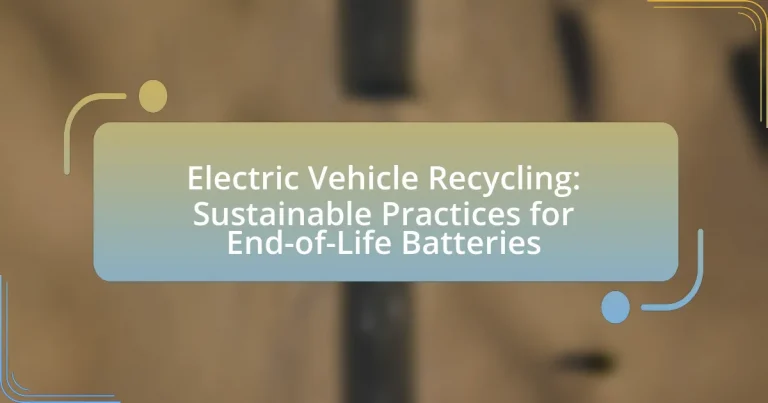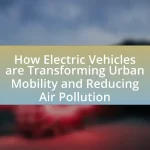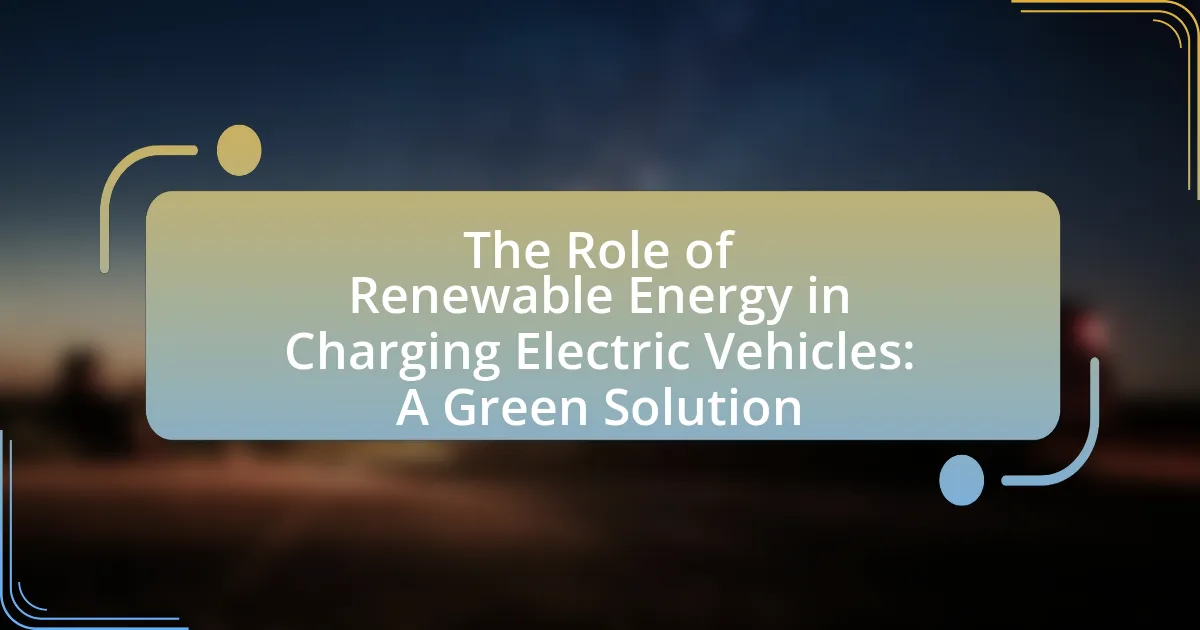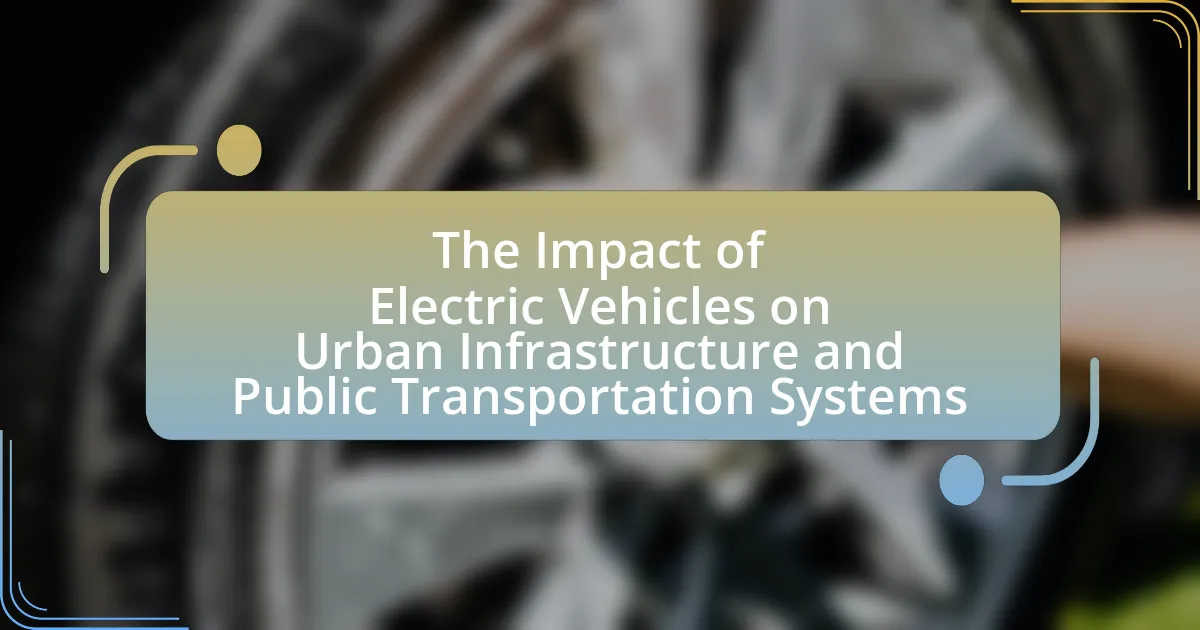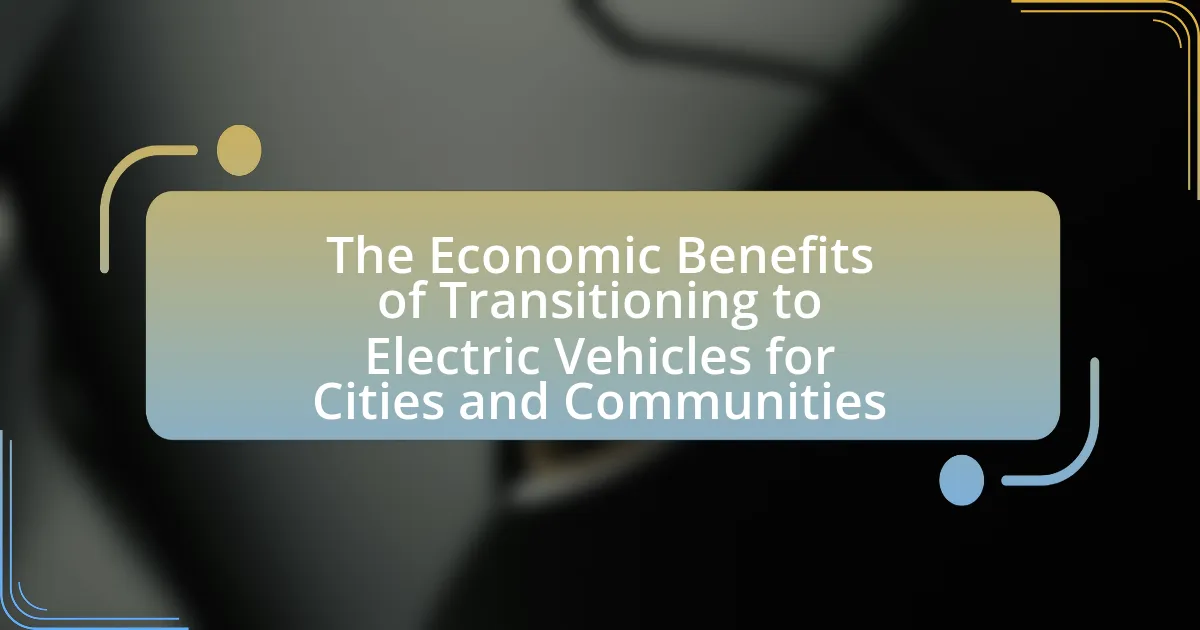Electric Vehicle Recycling is the process of recovering valuable materials from electric vehicle batteries at the end of their life cycle, focusing on components such as lithium, cobalt, and nickel. This practice is crucial for sustainability in the automotive industry, as it conserves resources, reduces environmental impact, and mitigates hazardous waste risks. The article outlines the importance of recycling, the environmental consequences of improper disposal, and the technologies and practices that enhance recycling efficiency. It also discusses the challenges faced in the recycling process, the role of regulations, and future trends aimed at promoting a circular economy in electric vehicle battery management.

What is Electric Vehicle Recycling?
Electric Vehicle Recycling refers to the process of recovering valuable materials from electric vehicles, particularly their batteries, at the end of their life cycle. This process involves dismantling the vehicle, extracting components such as lithium, cobalt, and nickel from batteries, and repurposing or recycling these materials to reduce environmental impact and conserve resources. According to the International Energy Agency, recycling can recover up to 95% of the materials in lithium-ion batteries, making it a crucial practice for sustainability in the automotive industry.
Why is recycling electric vehicle batteries important?
Recycling electric vehicle batteries is important because it conserves valuable materials and reduces environmental impact. The process recovers critical metals such as lithium, cobalt, and nickel, which are essential for new battery production. According to the International Energy Agency, recycling can recover up to 95% of these materials, significantly decreasing the need for mining, which is resource-intensive and environmentally damaging. Additionally, proper recycling mitigates the risk of hazardous waste from batteries entering landfills, thereby protecting ecosystems and human health.
What environmental impacts arise from improper disposal of EV batteries?
Improper disposal of EV batteries leads to significant environmental impacts, including soil and water contamination due to the leaching of toxic substances such as lithium, cobalt, and nickel. These heavy metals can disrupt ecosystems and harm wildlife, as evidenced by studies showing that contaminated water sources can adversely affect aquatic life. Additionally, the release of harmful chemicals into the atmosphere during improper incineration can contribute to air pollution, posing health risks to nearby communities. The accumulation of discarded batteries in landfills also exacerbates the depletion of natural resources, as valuable materials are lost instead of being recycled.
How does recycling contribute to sustainability in the automotive industry?
Recycling significantly contributes to sustainability in the automotive industry by reducing waste, conserving resources, and minimizing environmental impact. The process of recycling automotive materials, such as metals and plastics, allows for the recovery of valuable resources that can be reused in manufacturing new vehicles, thereby decreasing the need for virgin materials. For instance, the recycling of aluminum can save up to 95% of the energy required to produce new aluminum from ore. Additionally, recycling helps to lower greenhouse gas emissions associated with the production of new materials, contributing to a more sustainable automotive ecosystem. According to the Automotive Recyclers Association, recycling one vehicle can prevent the release of approximately 1.5 tons of carbon dioxide into the atmosphere.
What are the key components of electric vehicle batteries?
The key components of electric vehicle batteries are the anode, cathode, electrolyte, and separator. The anode typically consists of graphite, while the cathode is often made from lithium metal oxides, such as lithium nickel manganese cobalt oxide (NMC). The electrolyte, which facilitates the movement of lithium ions between the anode and cathode, is usually a lithium salt dissolved in a solvent. The separator is a porous membrane that prevents direct contact between the anode and cathode while allowing ion flow. These components work together to store and release electrical energy efficiently, making them crucial for the performance and longevity of electric vehicles.
What materials are commonly found in EV batteries?
Common materials found in EV batteries include lithium, cobalt, nickel, manganese, and graphite. Lithium is primarily used in the battery’s cathode, while cobalt and nickel enhance energy density and stability. Manganese contributes to safety and longevity, and graphite is utilized in the anode. These materials are essential for the performance and efficiency of lithium-ion batteries, which dominate the electric vehicle market. According to the International Energy Agency, the demand for these materials is expected to rise significantly as electric vehicle adoption increases, highlighting their critical role in battery technology.
How do these materials affect the recycling process?
Materials used in electric vehicle batteries, such as lithium, cobalt, and nickel, significantly impact the recycling process. These materials require specialized techniques for extraction and purification due to their chemical properties and the complexity of battery designs. For instance, lithium-ion batteries necessitate processes like pyrometallurgical and hydrometallurgical methods to recover valuable metals efficiently. According to a study published in the Journal of Cleaner Production, the recycling of lithium-ion batteries can recover up to 95% of lithium and cobalt, demonstrating the effectiveness of these methods. The presence of hazardous materials, such as lead or cadmium, can complicate recycling, necessitating stringent safety protocols and regulations to ensure environmental protection during the recycling process.

How does the electric vehicle battery recycling process work?
The electric vehicle battery recycling process involves several key steps: collection, disassembly, material recovery, and repurposing. Initially, used batteries are collected from various sources, including dealerships and recycling centers. Once collected, the batteries are disassembled to separate components such as the casing, electrodes, and electrolyte.
During material recovery, valuable materials like lithium, cobalt, and nickel are extracted through processes such as pyrometallurgical or hydrometallurgical methods. These materials can then be reused in new batteries or other applications, significantly reducing the need for virgin resources.
According to a report by the International Energy Agency, recycling can recover up to 95% of the materials in lithium-ion batteries, demonstrating the efficiency and sustainability of the recycling process. This comprehensive approach not only minimizes waste but also supports the circular economy in the electric vehicle industry.
What are the main steps involved in recycling EV batteries?
The main steps involved in recycling EV batteries include collection, disassembly, material recovery, and safe disposal. Initially, collection involves gathering used batteries from various sources such as dealerships and recycling centers. Following collection, disassembly is performed to separate the battery components, including the casing, electrodes, and electrolyte. The next step, material recovery, focuses on extracting valuable materials like lithium, cobalt, and nickel for reuse in new batteries or other applications. Finally, safe disposal ensures that any non-recyclable materials are handled in an environmentally responsible manner, adhering to regulations to prevent pollution. These steps are essential for minimizing waste and promoting sustainability in the lifecycle of electric vehicle batteries.
How are batteries collected and transported for recycling?
Batteries are collected for recycling through designated drop-off locations, collection events, and retailer take-back programs. These methods ensure safe handling and proper segregation of different battery types, such as lithium-ion and lead-acid, which are crucial for effective recycling processes. Once collected, batteries are transported in compliance with hazardous materials regulations, often using specialized containers to prevent leaks and ensure safety during transit. According to the U.S. Environmental Protection Agency, proper collection and transportation practices are essential to minimize environmental risks and maximize recovery of valuable materials from batteries.
What technologies are used to process EV batteries?
The technologies used to process EV batteries include hydrometallurgical processes, pyrometallurgical processes, and direct recycling methods. Hydrometallurgical processes involve leaching metals from battery materials using chemical solutions, which allows for the recovery of valuable metals like lithium, cobalt, and nickel. Pyrometallurgical processes involve high-temperature smelting to extract metals, but this method can be less efficient and environmentally friendly. Direct recycling methods focus on reusing battery components without breaking them down completely, which can preserve the structure and performance of the materials. These technologies are essential for recovering resources and minimizing environmental impact in the recycling of end-of-life EV batteries.
What challenges are faced in the recycling of electric vehicle batteries?
The recycling of electric vehicle batteries faces several significant challenges, including the complexity of battery chemistry, economic viability, and regulatory hurdles. The diverse chemistries used in electric vehicle batteries, such as lithium-ion, nickel-metal hydride, and others, complicate the recycling process because each type requires different handling and processing techniques. Economic viability is another challenge, as the costs associated with recycling can exceed the value of the recovered materials, making it less attractive for companies to invest in recycling infrastructure. Additionally, regulatory frameworks vary widely across regions, leading to inconsistencies in recycling practices and compliance requirements. These challenges hinder the development of efficient and sustainable recycling solutions for electric vehicle batteries.
What safety concerns are associated with battery recycling?
Battery recycling poses several safety concerns, primarily related to chemical exposure, fire hazards, and environmental contamination. The recycling process often involves handling hazardous materials such as lead, cadmium, and lithium, which can pose health risks if not managed properly. For instance, improper handling can lead to toxic exposure, resulting in respiratory issues or skin irritation. Additionally, batteries can be volatile; if damaged or improperly processed, they may catch fire or explode, posing risks to workers and facilities. According to the U.S. Environmental Protection Agency, improper disposal and recycling of batteries can also lead to soil and water contamination, further exacerbating environmental hazards.
How do economic factors influence the recycling process?
Economic factors significantly influence the recycling process by determining the cost-effectiveness and feasibility of recycling operations. For instance, the price of raw materials directly impacts the demand for recycled materials; when virgin material prices are high, recycling becomes more economically attractive. Additionally, government policies and subsidies can incentivize recycling initiatives, making them more financially viable. According to a report by the International Energy Agency, the economic viability of recycling lithium-ion batteries from electric vehicles is enhanced when the market price for lithium and cobalt rises, as it encourages investment in recycling technologies and infrastructure. Thus, economic conditions shape the recycling landscape by influencing both the supply and demand for recycled materials.

What sustainable practices are being implemented in EV battery recycling?
Sustainable practices in EV battery recycling include the use of hydrometallurgical processes, which efficiently recover valuable metals like lithium, cobalt, and nickel from spent batteries. These processes minimize environmental impact by reducing the need for mining new materials and lowering greenhouse gas emissions associated with traditional recycling methods. Additionally, companies are adopting closed-loop systems that allow for the reuse of recovered materials in new battery production, further enhancing sustainability. Research indicates that these practices can increase recycling efficiency by up to 90%, demonstrating their effectiveness in promoting a circular economy in the EV sector.
How can manufacturers improve the recyclability of EV batteries?
Manufacturers can improve the recyclability of EV batteries by designing them for easier disassembly and using recyclable materials. Implementing modular designs allows for efficient separation of components, which enhances the recycling process. Additionally, utilizing materials that are more readily recyclable, such as aluminum and certain plastics, can significantly reduce waste. Research indicates that battery recycling rates can exceed 90% when these practices are adopted, as seen in studies conducted by the International Energy Agency, which highlight the importance of material recovery in sustainable battery management.
What design considerations enhance battery recycling?
Design considerations that enhance battery recycling include modularity, material selection, and ease of disassembly. Modularity allows for easier replacement of individual components, facilitating the recycling process by enabling the recovery of valuable materials without damaging the entire battery system. Selecting recyclable materials, such as lithium, cobalt, and nickel, ensures that the components can be efficiently processed and reused in new batteries. Additionally, designing batteries for ease of disassembly minimizes labor and time during the recycling process, which can significantly reduce costs and improve recovery rates. Research indicates that implementing these design strategies can lead to a more sustainable lifecycle for batteries, ultimately supporting the circular economy in electric vehicle production.
How do closed-loop systems contribute to sustainability?
Closed-loop systems contribute to sustainability by enabling the recycling and reuse of materials, thereby minimizing waste and reducing the need for new resource extraction. In the context of electric vehicle recycling, these systems allow for the recovery of valuable components from end-of-life batteries, such as lithium, cobalt, and nickel, which can be reintroduced into the production cycle. This process not only conserves natural resources but also significantly lowers greenhouse gas emissions associated with mining and manufacturing new materials. For instance, a study by the International Energy Agency indicates that recycling lithium-ion batteries can reduce carbon emissions by up to 90% compared to traditional mining methods.
What role do regulations play in EV battery recycling?
Regulations play a crucial role in EV battery recycling by establishing standards and guidelines that ensure safe, efficient, and environmentally responsible disposal and recycling processes. These regulations mandate the collection, transportation, and recycling of batteries, thereby minimizing hazardous waste and promoting resource recovery. For instance, the European Union’s Battery Directive requires manufacturers to take responsibility for the entire lifecycle of batteries, including end-of-life management, which has led to increased recycling rates and reduced environmental impact. Additionally, regulations often incentivize the development of advanced recycling technologies, ensuring that valuable materials such as lithium, cobalt, and nickel are recovered and reused, thus supporting a circular economy.
What are the current regulations governing battery recycling?
Current regulations governing battery recycling include the Resource Conservation and Recovery Act (RCRA) in the United States, which classifies batteries as hazardous waste if they contain toxic materials. The RCRA mandates proper disposal and recycling practices to minimize environmental impact. Additionally, the European Union’s Battery Directive establishes requirements for the collection, recycling, and disposal of batteries, aiming for a minimum recycling rate of 50% for portable batteries and 70% for industrial batteries by 2025. These regulations are designed to promote sustainable practices and ensure that hazardous materials are managed responsibly, thereby protecting public health and the environment.
How do these regulations impact recycling practices?
Regulations significantly enhance recycling practices for electric vehicle batteries by establishing standards that ensure safe and efficient processing. These regulations mandate the proper handling of hazardous materials, which reduces environmental risks and promotes the recovery of valuable resources. For instance, the European Union’s Battery Directive requires that at least 50% of lithium-ion battery components be recycled, thereby incentivizing manufacturers to develop more effective recycling technologies. This regulatory framework not only drives innovation in recycling methods but also increases the overall recycling rates of end-of-life batteries, contributing to a more sustainable circular economy.
What are the future trends in electric vehicle battery recycling?
Future trends in electric vehicle battery recycling include the development of advanced recycling technologies, increased regulatory support, and a shift towards circular economy practices. Advanced recycling technologies, such as hydrometallurgical and biotechnological methods, are being researched to improve recovery rates of valuable materials like lithium, cobalt, and nickel, which are essential for battery production. Regulatory support is expected to grow, with governments implementing stricter recycling mandates and incentives to promote sustainable practices. Additionally, the shift towards a circular economy emphasizes the importance of reusing and repurposing battery materials, reducing waste, and minimizing the environmental impact of battery disposal. These trends are driven by the increasing demand for electric vehicles and the need for sustainable resource management in the face of growing environmental concerns.
How is technology evolving to improve recycling efficiency?
Technology is evolving to improve recycling efficiency through advancements in automated sorting systems and enhanced chemical processes. Automated sorting systems utilize artificial intelligence and machine learning to identify and separate different materials more accurately and quickly, significantly reducing contamination rates. For instance, a study by the National Renewable Energy Laboratory found that AI-driven sorting can increase the recovery rates of valuable materials from batteries by up to 30%. Additionally, innovations in chemical recycling methods allow for the breakdown of complex materials into their base components, enabling the recovery of rare metals like lithium and cobalt from electric vehicle batteries. This process not only enhances material recovery but also minimizes waste, contributing to a more sustainable recycling ecosystem.
What innovations are being developed for battery reuse and repurposing?
Innovations for battery reuse and repurposing include advanced second-life applications, where used electric vehicle batteries are transformed into energy storage systems for renewable energy sources. Companies like Tesla and Nissan are developing systems that allow these batteries to store solar energy, thereby extending their lifecycle and reducing waste. Additionally, research is focusing on battery refurbishment techniques that enhance performance and safety, enabling batteries to be used in less demanding applications, such as stationary energy storage. The International Energy Agency reported that repurposing batteries can significantly lower costs and environmental impacts associated with battery disposal, highlighting the importance of these innovations in promoting sustainability in the electric vehicle sector.
What best practices can consumers follow for responsible EV battery disposal?
Consumers should return electric vehicle (EV) batteries to authorized recycling centers or dealerships for responsible disposal. This practice ensures that hazardous materials are handled safely and that valuable components are recovered for reuse. According to the U.S. Environmental Protection Agency, recycling lithium-ion batteries can recover up to 95% of the materials, significantly reducing environmental impact. Additionally, consumers should avoid throwing batteries in regular trash, as improper disposal can lead to soil and water contamination. Following these best practices contributes to sustainable battery management and supports the circular economy.
